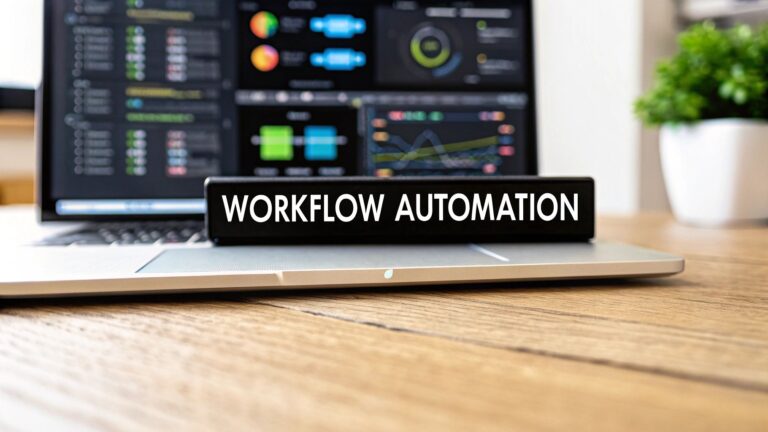Streamlined How-to Techniques For Optimizing AI Workflow Automation
You can unlock significant efficiency and productivity gains by mastering AI workflow automation. In this post, you’ll discover streamlined techniques that will help you effectively automate tasks and processes in your organization, ensuring maximum output with minimal effort. Harness the power of AI to eliminate repetitive tasks, improve accuracy, and free up valuable time for your team. For a deeper investigate this transformative subject, check out AI Workflow Automation: A New Era of Streamlined … and elevate your understanding of automation methods.
Key Takeaways:
- Identify bottlenecks in your current workflow to enhance efficiency and streamline processes.
- Leverage data collection for informed decision-making to effectively automate tasks.
- Integrate AI tools that complement existing systems and promote seamless communication across platforms.
- Regularly evaluate AI performance to make adjustments and optimize outcomes continuously.
- Focus on user training to ensure that teams are equipped to maximize the benefits of automation.
Understanding AI Workflow Automation
A comprehensive understanding of AI workflow automation is crucial for optimizing processes and enhancing productivity in your organization. By automating repetitive tasks, you free up valuable time for your team, allowing them to focus on more strategic initiatives. This technology not only improves efficiency but also reduces the likelihood of human error, leading to better overall results.
Definition and Importance
To define it simply, AI workflow automation involves employing artificial intelligence to streamline and manage tasks within a workflow, making processes more efficient. This is important as it enhances operational efficiency, reduces costs, and enables your team to concentrate on tasks that require human insight and creativity.
Key Components
For a successful AI workflow automation system, you should focus on several key components including data management, integration capabilities, workflow mapping, and user interfaces. Each element plays a significant role in ensuring a seamless operation.
The key components of AI workflow automation are vital for its effectiveness. Data management ensures that the correct information is collected and utilized, while integration capabilities allow different tools and platforms to work together seamlessly. Workflow mapping is crucial for visualizing tasks and processes, and a user-friendly interface ensures that your team can easily interact with the automation tools. Neglecting any of these components can lead to inefficiencies and challenges in optimizing your AI automation efforts.
How-to Identify Optimization Opportunities
There’s a constant need to refine your AI workflow automation to ensure it’s operating at peak efficiency. Identifying optimization opportunities involves looking for bottlenecks, redundant steps, and areas where technology can enhance productivity. By strategically assessing these elements, you can create a more streamlined workflow tailored to your organization’s unique needs.
Analyzing Current Workflows
While assessing your current workflows, examine each step meticulously to uncover inefficiencies. Break down processes into manageable segments and assess the time and resources allocated to each task. This dissection allows you to spot areas that are not adding value and can be improved or eliminated.
Gathering Feedback from Users
The input you receive from users can serve as a powerful tool in optimizing AI workflows. Understanding their experiences helps illuminate both the strengths and weaknesses of your systems. Seeking regular feedback encourages collaboration and innovation, leading to a more effective automation strategy.
From user feedback, you can gain insight into specific challenges they face, such as frustrating bottlenecks or repetitive tasks that hinder productivity. Encourage users to share their experiences, which not only fosters team engagement but also provides you with valuable suggestions for enhancements. By prioritizing feedback, you can focus on the most impactful changes, ensuring your workflow is both efficient and user-friendly.
How-to Implement Streamlined Techniques
For effective implementation of streamlined techniques in AI workflow automation, you should focus on a structured approach. Start by assessing your current processes to identify areas that can benefit from automation. Gradually integrate tools and refine workflows by utilizing the insights gained from performance analytics. This method helps ensure a more organized system and a smoother transition for your team. Continuous monitoring and adjustments will also be key to maintaining efficiency and relevancy.
Prioritizing Tasks for Automation
To prioritize tasks effectively, you need to evaluate which processes consume the most time and resources. Focus on automating repetitive, time-intensive tasks that can lead to increased productivity and reduced errors. Also, consider the potential impact on your team’s workflow—tackle tasks that, when automated, can significantly streamline operations. By prioritizing wisely, you’ll pave the way for a more efficient automation strategy.
Selecting the Right Tools and Technologies
Now, when it comes to selecting the right tools and technologies for your automation tasks, it’s crucial to evaluate their compatibility with your existing systems and processes. Your choice should balance performance, user-friendliness, and scalability. Prioritize solutions that foster collaboration and provide robust support.
Tools play a significant role in your AI workflow automation success. It’s advisable to choose platforms that offer strong integration capabilities with your current systems, as this can minimize disruptions. Explore options that come with comprehensive support and documentation, ensuring easy onboarding for your team. Additionally, selecting highly rated systems with flexible customization features can enhance your workflow while catering to specific business needs. Always consider the long-term implications of your choices, as investing in the right technologies today can pay off significantly in operational efficiency and sustainability.

Tips for Continuous Improvement
After implementing AI workflow automation, it’s important to focus on continuous improvement to maximize results. Here are some effective tips:
- Regularly assess workflow automation processes
- Gather feedback from team members
- Stay updated on AI advancements
- Conduct periodic training sessions
Assume that consistent evaluation will lead to ongoing enhancements in your workflow.
Monitoring Performance Metrics
With the right tools in place, you can effectively monitor performance metrics to ensure your AI workflow automation is functioning optimally. Tracking key indicators such as task completion time, error rates, and user satisfaction can provide valuable insights. Utilize data visualization tools to analyze these metrics regularly, enabling you to make necessary adjustments for greater efficiency.
Encouraging Team Collaboration
Even with automation, fostering team collaboration is vital for success. Encouraging open communication and collaboration among team members promotes a culture of shared responsibility for the success of AI initiatives. You can achieve this by organizing regular brainstorming sessions, utilizing collaboration tools, and setting clear roles that respect each member’s strengths. This approach not only enhances the effectiveness of your workflow but also improves overall morale within your team.
A successful AI workflow hinges on strong teamwork. By creating an environment where team members feel comfortable sharing ideas, you stimulate innovation and creativity in problem-solving. Encourage teams to address challenges together, as collaborative efforts can lead to cutting-edge solutions. As your team takes ownership of workflow optimization, they become more invested in achieving shared goals, leading to a more effective and engaged workforce.
Factors Influencing Successful Automation
Your journey towards automating workflows is shaped by multiple factors that dictate the success of your efforts. Consider the following important elements:
- Organizational culture
- Staff training
- Technology integration
- Change management
Assume that understanding these influences will not only enhance your approach but also streamline your AI Workflow Automation and Orchestration.
Organizational Culture
Now, the essence of organizational culture plays a vital role in your automation success. A culture that embraces innovation, collaboration, and continuous improvement encourages your team to engage with and support automation initiatives effectively.
Staff Training and Skill Development
Influencing effective staff training and skills development is paramount for the automation process. Employees equipped with the right skills can more effectively adapt to new technologies, ensuring a smoother transition to automated workflows.
Culture around staff training significantly impacts your automation outcome. An environment dedicated to ongoing learning creates a sense of ownership and confidence among employees. Providing resources for skill enhancement facilitates adoption while reinforcing a growth mindset. Neglecting this aspect can lead to resistance and setbacks, emphasizing the need for a comprehensive approach to training that addresses both technical skills and change adaptation.

How-to Troubleshoot Common Issues
Keep in mind that troubleshooting is vital for maintaining effective AI workflow automation. Begin by identifying errors promptly and referring to resources such as the Complete Guide to AI Workflow Automation: Streamlining … for step-by-step resolutions. Maintaining a structured approach to address common problems ensures that your processes continue to run smoothly and efficiently.
Identifying Bottlenecks
With a keen eye on your workflow, you can easily identify bottlenecks that may be slowing down your AI processes. Look for areas where tasks pile up or delay production, as these often signal inefficiencies that need immediate attention. Analyzing performance data can also provide insights into where adjustments are necessary, allowing you to streamline your workflow effectively.
Maintaining Flexibility in Processes
With a flexible approach to your AI workflow, you can adapt to changes quickly and efficiently. As business requirements evolve, your processes should too; being rigid can lead to stagnation. Regularly review your workflows to ensure they allow for modifications without major disruptions.
Plus, maintaining flexibility in your processes offers the advantage of scalability and agility. By implementing modular designs, you can easily add or remove components as business needs change, ensuring that your system remains relevant and effective. This flexibility is vital for responding to market shifts and can enhance productivity, ultimately leading to improved outcomes. Embracing a dynamic approach will keep your workflow optimized and resilient, positioning you ahead in the rapidly evolving landscape of AI automation.
Conclusion
Considering all points, optimizing your AI workflow automation is necessary for enhancing efficiency and productivity. By adopting streamlined techniques and integrating best practices, you can significantly improve your processes and outcomes. Focus on identifying key areas for automation, continuously monitoring performance, and being open to adjustments as needed. With these strategies, you can fully harness the potential of AI to transform your workflow and drive outstanding results.
FAQ
Q: What are the key steps involved in optimizing AI workflow automation?
A: To effectively optimize AI workflow automation, it is necessary to follow several key steps:
1. Assessment of Current Processes: Begin by analyzing the existing workflows to identify bottlenecks and areas for improvement.
2. Data Preparation: Ensure that the data being used is clean, relevant, and well-structured to facilitate better decision-making by AI models.
3. Select the Right Tools: Choose automation tools and AI technologies that align with your specific needs and can easily integrate into your existing systems.
4. Feedback Loops: Implement feedback mechanisms to continually monitor performance and make adjustments as needed to enhance efficiency.
Q: How can organizations measure the effectiveness of their AI workflow automation?
A: Organizations can measure the effectiveness of their AI workflow automation through several metrics:
1. Process Efficiency: Evaluate the time taken to complete specific tasks before and after automation implementation.
2. Error Rates: Monitor the frequency of errors in processes that have been automated to determine if the automation has reduced mistakes.
3. Cost Savings: Analyze financial outcomes by comparing operational costs prior to and post-implementation of AI workflow automation.
4. User Satisfaction: Gather feedback from team members who use the automated systems to assess usability and overall satisfaction.
Q: What are common challenges faced during the optimization of AI workflow automation?
A: Some common challenges organizations may encounter include:
1. Data Quality Issues: Inconsistent or inaccurate data can hinder the performance of AI models and lead to suboptimal automation outcomes.
2. Change Management: Employees may resist adapting to new technologies and workflows, which can slow down the implementation process.
3. Integration Complexity: Ensuring that new AI tools work seamlessly with existing systems can be technically challenging and resource-intensive.
4. Skill Gaps: Organizations may struggle to find employees with the necessary skills to manage and optimize AI systems effectively, hindering progress.







